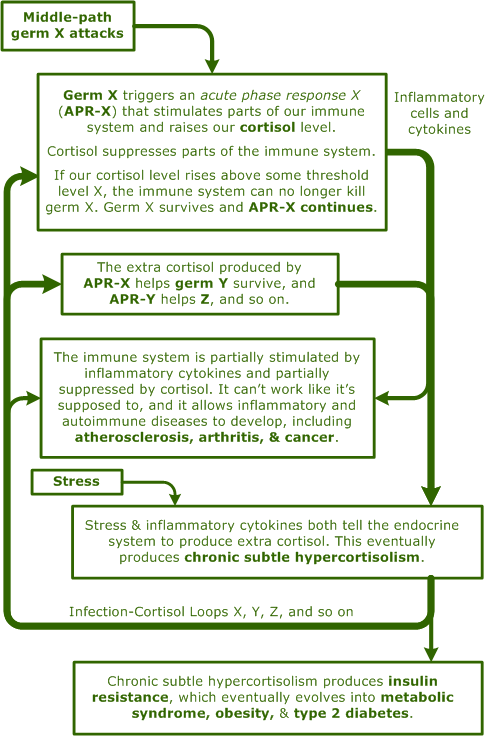I have a huge amount of information on immunosenescence beyond the material presented below. It involves T-cells, B-cells, and a myriad of strange sounding biochemicals. I don't have a good, readable explanation of it ready yet. Wikipedia's description is at: en.wikipedia.org⁄wiki⁄Immunosenescence
Immunosenescence
This chapter will describe how infections weaken our immune systems and the weakened immune system allows us to be infected with still more germs. This vicious cycle causes us to accumulate infections at an exponential rate as we age.
Cortisol and immunosenescence
The previous chapter described infection-cortisol loops and told how some germs--the middle-path germs--exploit the loops and cause chronic infections.
When we pick up a new middle-path infection, we usually live pretty much as we did before, but we have slightly higher levels of inflammation and cortisol. Many of us will eat a little more and sleep a little less. We don't get as much pleasure out of exercise so we do a little less of it. Our quality of life decreases slightly, but not enough to make us remember the week or the month when the middle-path germ struck us.
Since our cortisol is a little higher than it was before, our immune system won't be quite as effective as it was, and we will be more susceptible to the next germ that we encounter. This causes what might be called a pathogen cascade. This is pretty complicated stuff, but the drawing below tries to show what happens as we get older in a world full of germs.

Most middle-path infections last a lifetime, so our "infectious burden" increases every time we get a new one. Each infection makes us more susceptible to the next one; this is immunosenescence.
Keep this in mind--Mother Nature optimized the immune and endocrine systems to keep young adults alive and active long enough to bear and rear children. The pathogen cascade described above dysregulates the immune and endocrine systems of older people to such an extent that they can no longer protect us from cancer, autoimmune diseases, or additional infections. The result is what we call old age or senescence, and it begins with immunosenescence.
Although "senescence" refers to old age, immunosenescence begins in childhood and gets worse every year. Consequently, we pick up infections at an ever-accelerating rate as we age. Similarly, our health declines at an ever-accelerating rate. This is the falling apart syndrome.
A good question. An observant reader might wonder why we evolved a system that is guaranteed to cripple and kill us in the long run. The full answer to this question fills books, but I can summarize it briefly.
Germs are always evolving, and they can evolve faster than we can. Mother Nature had to come up with a germ-killing system that would keep us alive and active long enough to raise children. She succeeded pretty well--the infection-cortisol loop allows most of us to thrive until we are in our Forties. After that. Mother nature loses interest in us and we are on our own.
Nuclear Factor Kappa B (NFKB)
In a previous chapter I said that Mother Nature had been refining infection-cortisol loops for 500 million years. One of those refinements involves nuclear factor Kappa B (NFKB, en.wikipedia.org⁄wiki⁄NF-%CE%BAB)
Infected cells sometimes protect their neighbors from infection by committing suicide (apoptosis) before the germs in them have finished reproducing. Cells activate NFKB to prevent themselves from committing suicide unnecessarily.
Many intracellular germs--germs that live inside of host cells--trick cells into activating too much NFKB. This ensures that the cells will live long enough for the invading organisms to reproduce at their leisure.
Persistent activation of NFKB is a characteristic of obesity, type 2 diabetes, atherosclerosis, multiple sclerosis, schizophrenia, and many other diseases linked to intracellular germs.
Lots of pathogens activate NFKB. Petersen et al. found that Trypanosoma cruzi prevent infected heart cells from committing apoptosis by activating NFKB. This allows T. cruzi organisms to thrive in heart muscle cells (Trypanosoma cruzi is an important cause of heart disease in South America).
Many other refinements of the infection-cortisol loop will be discussed in later versions of this manuscript.
More information on infections, cortisol, and aging
Infection-cortisol loops are discussed briefly in Chapters 3 and 17 of The Potbelly Syndrome.
To see a list of the diseases linked to Chlamydophila pneumoniae (CPN), check Appendix II or look at www.potbellysyndrome.com⁄attach⁄CPN.pdf.
Da Prato RA, Rothschild J. The AIDS virus as an opportunistic organism inducing a state of chronic relative cortisol excess: therapeutic implications. Med Hypotheses. 1986 Nov;21(3):253-66.
Ewald PW. Evolution of virulence. Infect Dis Clin North Am. 2004 Mar;18(1):1-15. Review.
http:⁄⁄pubs.niaaa.nih.gov⁄publications⁄arh26-4⁄257-263.pdf. Alcohol and immune suppression.
Rupprecht HJ, Blankenberg S, Bickel C, Rippin G, Hafner G, Prellwitz W, Schlumberger W, Meyer J; AutoGene Investigators. Impact of viral and bacterial infectious burden on long-term prognosis in patients with coronary artery disease. Circulation. 2001 Jul 3;104(1):25-31.
Wick G, Berger P, Jansen-Durr P, Grubeck-Loebenstein B. A Darwinian-evolutionary concept of age-related diseases. Exp Gerontol. 2003 Jan-Feb;38(1-2):13-25. Review.